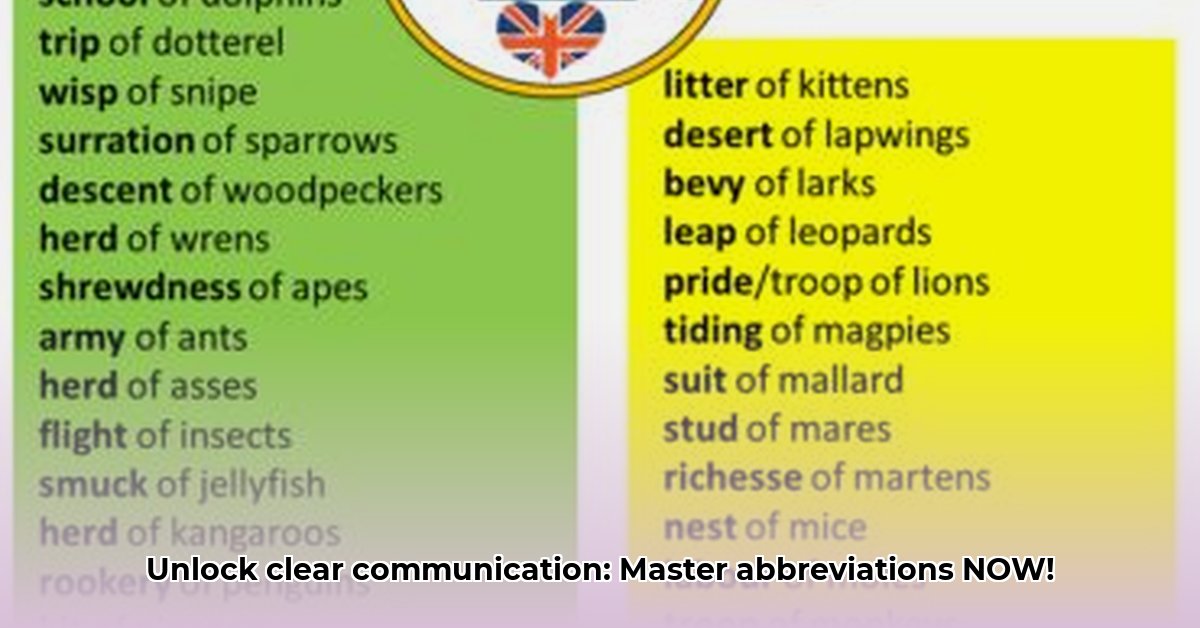
Let's be honest: abbreviations and acronyms are ubiquitous! They offer a shortcut to concise communication, but misused, they create confusion. This guide empowers you to use collective abbreviations effectively, ensuring clear and efficient communication.
Understanding the Nuances of Collective Abbreviations
Why condense phrases? Simply put: efficiency! Repeating full names incessantly is tedious. Collective abbreviations streamline writing and speaking.
However, what's clear to you might be gibberish to others. An abbreviation common in your workplace could be unintelligible to an outsider. Furthermore, the same abbreviation can hold different meanings across fields (e.g., "LASER" in physics vs. another field). Context is crucial. Misunderstanding arises from a lack of context.
Crafting Crystal-Clear Collective Abbreviations: A Step-by-Step Guide
Creating effective abbreviations is both art and science. Here's how to do it right:
Step 1: Choose Wisely
Select memorable and easily understood abbreviations for your target audience. Avoid obscurity and complexity. Opt for common words or pronounceable letter combinations.
Step 2: Define Explicitly
Always explain a new abbreviation's meaning upon its first use. Don't leave readers guessing! For instance: "The World Health Organization (WHO) recently published a report…"
Step 3: Maintain Consistency
Once an abbreviation is chosen, stick with it. Switching between full name and abbreviation creates confusion. Consistency is key. Utilize a style guide for consistent usage.
Step 4: Know Your Audience
Tailor abbreviation usage to your audience's familiarity with the subject. Experts tolerate more specialized terms than general audiences. Prioritize clarity over technical jargon.
Step 5: Prioritize Brevity, but Not at the Expense of Clarity
Avoid overwhelming readers with excessive abbreviations. Balance brevity with comprehension. A few key, consistently used abbreviations are more effective than a plethora of obscure ones.
Real-World Examples and Best Practices
Consider a report on sleep disorders. Instead of repeatedly writing "National Institutes of Health," use "NIH" after introducing it: “The National Institutes of Health (NIH) recently published research on…” This balances efficiency with clarity.
Common Mistakes to Avoid
Let's examine potential pitfalls and solutions:
| Problem | Solution | Example |
|---|---|---|
| Overusing Abbreviations | Use sparingly; clarity trumps brevity. | Instead of "NASA, WHO, and the UN...", try "NASA, the World Health Organization, and the United Nations..." |
| Inconsistent Usage | Create and follow a style guide. | If "CEO" is used for "Chief Executive Officer," maintain this throughout. |
| Insufficient Context | Always define abbreviations upon first use; use a glossary if necessary. | Provide the full term, followed by the abbreviation in parentheses. |
| Vague or Obscure Abbreviations | Choose clear, easily understood terms. | Avoid internal jargon unfamiliar to your audience. |
Long-Term Strategies: Effective Abbreviation Management
Creating a robust abbreviation system is an ongoing process. Regularly review and update your abbreviations to accommodate language and technological evolution. Consider employing dedicated software or databases for tracking and managing abbreviations. Proactive management promotes consistency and avoids misunderstandings. Remember, effective communication is paramount. While abbreviations save space and time, clarity should always take precedence. Prioritize understanding, and your message will resonate with your audience.
Key Takeaways: Crafting Effective Abbreviations and Acronyms for Technical Documentation
- Clearly define all abbreviations and acronyms on first use.
- Balance brevity and clarity; avoid excessive abbreviation.
- Maintain consistency throughout the document.
- Consider your audience's technical expertise.
- Follow established style guides and best practices.
- Utilize software tools to maintain consistency and catch undefined terms.